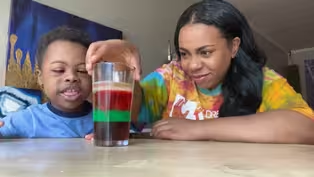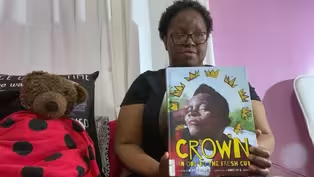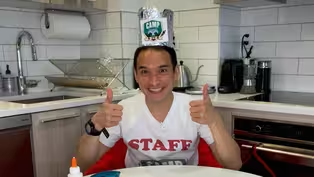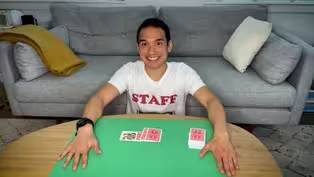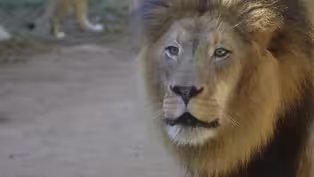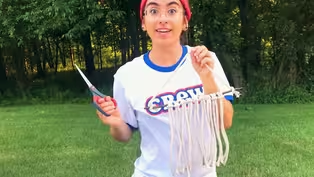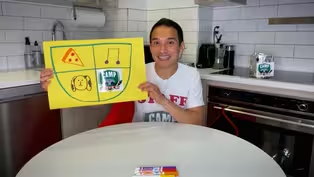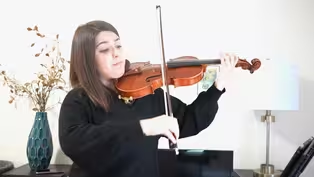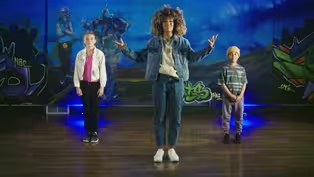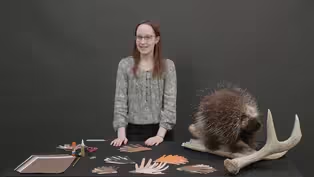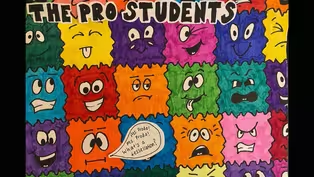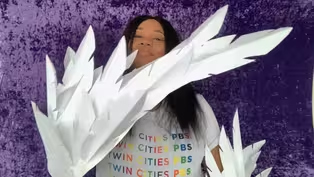
Royalty Day (Long Version)
7/1/2021 | 56m 46sVideo has Closed Captions
Read CROWN, make a crown and a coat of arms, meet the king of the jungle!
Join head counselor Zach to read CROWN, make a crown and a coat of arms, meet the king of the jungle! Learn hip hop moves, turn lemons into lemonade, create tessellations and an animal craft. Content partners include America’s Test Kitchen Kids, Children's Museum of Acadiana, Minnesota Zoo, NJ DOE, NY Philharmonic, NY Public Library, NY State Museum, San Diego Zoo, They Might Be Giants, 1520 Arts.
Problems playing video? | Closed Captioning Feedback
Problems playing video? | Closed Captioning Feedback
Camp TV is a local public television program presented by THIRTEEN PBS

Royalty Day (Long Version)
7/1/2021 | 56m 46sVideo has Closed Captions
Join head counselor Zach to read CROWN, make a crown and a coat of arms, meet the king of the jungle! Learn hip hop moves, turn lemons into lemonade, create tessellations and an animal craft. Content partners include America’s Test Kitchen Kids, Children's Museum of Acadiana, Minnesota Zoo, NJ DOE, NY Philharmonic, NY Public Library, NY State Museum, San Diego Zoo, They Might Be Giants, 1520 Arts.
Problems playing video? | Closed Captioning Feedback
How to Watch Camp TV
Camp TV is available to stream on pbs.org and the free PBS App, available on iPhone, Apple TV, Android TV, Android smartphones, Amazon Fire TV, Amazon Fire Tablet, Roku, Samsung Smart TV, and Vizio.
Providing Support for PBS.org
Learn Moreabout PBS online sponsorship- Hi everybody.
My name is Zach and welcome to "Camp TV."
Are you ready for some summer fun?
Me, too.
Now, as your head counselor, I will be introducing you to all sorts of cool activities.
Arts, crafts, games, math and science, as well as some of my favorite books, nature and theater.
I will be here to take you from one activity to the next.
So follow me on "Camp TV."
[bright music] - [Announcer] This program was made possible in part by the Corporation for Public Broadcasting, a private corporation funded by the American people.
Additional funding was provided by the Peter G. Peterson and Joan Ganz Cooney Fund and the Pine Tree Foundation of New York.
[ukulele strumming] ♪ Camp TV ♪ ♪ It's time for us to start ♪ ♪ From furry animal encounters ♪ ♪ Summer reading and the arts ♪ ♪ No matter what the weather ♪ ♪ We'll explore it all together ♪ ♪ It's a place for you and me ♪ ♪ It's Camp TV ♪ [clearing throat] [trumpet music] - Hear ye, hear ye.
All loyal friends of the "Camp TV" kingdom, make way for His Royal Highness, reigning head counselor, not to mention all around great guy, King Zach.
[trumpet music] Ladies and lords, princes and princesses, knights and nobles.
Good morrow to you all.
Today is a day like no other.
A day, dare I say, fit for a king or queen, as the case may be.
You are hereby notified by royal proclamation that today is Royalty Day on "Camp TV."
Happily, I see you've donned your best, and I trust you've come prepared for all responsibilities that come your way.
Today we begin with catapults and archery first, followed by a no-sew, design your own armor tunic in arts and crafts.
And then, well, I hate to be the bearer of bad news, but I'm afraid it's your turn to clean up after the stadium unicorns.
[sniffing] Whew!
But the good news is, it's followed by an extravagant banquet hosted by moi, where we will be partaking my favorite meal: meat pie made of gosling, three capons, six chickens, 10 pigeons, and a side of stuffing, minced loin of veal, two pounds of fat, and 26 hard boiled eggs covered with saffron and flavored with cloves.
[inhaling] Mmm.
[horse whinnying] Hark, 'tis my carriage.
I must bid thee farewell.
[horse whinnying] Okay, I'm coming.
Geesh.
[clearing throat] Ha.
And you, make haste.
'Tis the hour for your first activity.
[horse whinnying] Seriously, I'm in the middle of something right now.
[clearing throat] Until we meet again.
[horse whinnying] [Zach muttering] A little birdie told me it's time to go wild.
- When it comes to the animal kingdom, lions are known as the king of beasts, and there are many reasons why this big cat rules.
Lions live in groups called prides that contain females and their cubs, a few related young males, and one adult male.
Most adult male lions have manes, while females are sleek.
There can be from three to 30 lions in a pride.
The lionesses work together to hunt and raise the cubs while the big male guards the pride and protects the territory.
Lions are famous for their roar, which is how pride members keep in touch with each other and warn other lions that this territory is taken.
Have you ever heard the expression taking a cat nap?
Well, lions like those a lot.
They can sleep about 20 hours a day!
With their golden coat, impressive roar, and playful cubs, it's easy to see why lions are so popular at the San Diego Zoo and Safari Park.
And that's no lie-on.
[lion roaring] - [Zach] Jump, dance, play.
It's time to get active.
Let's move.
- What's up, everybody.
My name is Precious.
Today I have... - Claire.
- Claire and... - Ian.
- Ian helping me out.
Today we're just gonna go through some basic party hip hop dance moves.
This first move is called an East Coast Stomp.
So, the East Coast Stomp, all you need is your midsection and your knees to be working.
So with my midsection, I'm gonna do a move called the rock, and that's just me leaning forward really.
So you're just gonna lean with it, lean with it, lean with it, lean with it, lean with it, lean with it.
Good.
And I want my focus to be the forward motion.
Forward, forward, forward.
Now at the same time, my legs are gonna come up.
I'm gonna do the right leg, or the left leg first, and I'm gonna bend and pretend like I need to hit my knee to my chest.
So I'm gonna hit it, hit it.
Pretend like you're hitting, hitting, hitting.
Good, I'm gonna face the front a little bit, so march forward.
It's kind of just a little march, and I'm just gonna lean forward, lean forward, lean forward, pretend to hit my chest.
Right?
So we got my legs goin', my chest going, and now we have to add style with our arms.
So I can do whatever I want with my arms.
Just make sure we're doing something with our arms other than this.
So let's get this march going.
We're gonna East Coast Stomp here.
And then when I say go, you're gonna add your arms.
Ready?
Five, six, seven, eight, go.
Arms, arms, arms, arms, arms, arms, arms.
Nice.
All right, everybody.
Our second move is called the Happy Feet.
So we're gonna start where I like to call home.
I'm gonna bend my knees and we're gonna start at home.
I'm gonna jump out of home and I always gotta come back, so I'm gonna be jumping to the right, come back home, to the left, come back home.
When I jump out, I gotta jump on a heel and a toe, so I'm gonna put my heel out just like this and pop up on my toe.
And then you're gonna come back home real quick.
Same thing, other side.
Heel.
Toe.
Come back real quick.
We're just gonna pop on that really quick, so start home.
Ready, we got five, six, seven, this way.
Heel, toe, come back.
Heel, toe, come back.
Heel, toe, back.
Heel, toe, back.
Good.
This is all what Happy Feet is.
And now we gotta add style.
So, same thing.
We gotta add our arms however you wanna add your arms.
I can use my arms like this.
I can fold 'em behind me.
I can fold 'em in front of me.
So starting at home, add some arms a little bit for style.
Ready, five, six, happy feet, go.
Heel, toe, middle.
Heel, toe.
Heel, toe.
Heel, toe.
Speed it up.
Heel, toe.
Heel, toe.
Heel, toe.
Heel, toe.
Heel, toe.
Heel, toe.
Add your arms.
[hip hop music] Good.
And stop.
That is the Happy Feet.
All right, this last move is called the Gucci.
The Gucci is really just two hops to the right and two hops to the left.
So, I'm gonna start with my legs together here, and I'm gonna hop like this.
Hop once, bend my knees, hop twice.
And then go this way now.
Bend my knees, hop once.
Bend my knees, hop twice.
Nice.
Now I gotta add my arms here.
I'm gonna pretend like I'm hitting a table.
Yeah, and I'm gonna start back and pound it down.
Start back, pound it down.
So I'm gonna bend my knees, crank it back, and pound it, and jump at the same time.
So, we start here at the middle.
Lean it back.
We got five, six, Gucci this way.
Go one, two.
And one, two.
Good.
That's what a Gucci is.
We're gonna speed it up just a little bit.
Ready, five, six.
Gucci, go.
Little faster.
Little faster.
Hey, hey, little faster.
Little faster.
Good.
You can feel free to use your arms how you want because the Gucci was actually a move to show off your style, so whatever shoes you were rocking, whatever clothes you were rocking, you kind of want to show it off so I don't just have to do this each time I do a Gucci.
[hip hop music] Ready, add some style.
Play with your clothes.
We got five, six, Gucci, go.
You can brush it.
I can brush it.
I can pound it.
I can pound it.
Good, that's a Gucci.
[hip hop music] - Welcome back, Your Majesties.
Are you tired of having only one crown lying around the house?
I mean, what happens when it's in the shop being polished?
Or your siblings borrowed it again for the 100th time this week?
Well, I've got just the answer.
Today we are making a back up crown.
You will need some cardboard that's thick enough to stand, but thin enough to bend, something like a cereal box.
Some scissors, glue, tape or stapler, some tin foil, and some items to bejewel and bedazzle.
Start with a piece of cardboard that's long enough so that it can go around your head.
Cut a strip and leave enough width to cut a zigzag shape on top.
Next, take some aluminum foil and wrap it all around.
[bright acoustic music] Cut a zigzag shape along the top of the crown.
Then decorate your crown with whatever you please.
[bright acoustic music] Oh, yeah.
There we go.
When it's decorated to your liking, you can tape or staple the crown from the inside and knight yourself royalty.
Huzzah!
Perfect!
Mmm, let's get cooking.
- Hi, I am Henry with America's Test Kitchen Kids, and today I am going to be showing you how to zest a lemon, juice a lemon, and make some amazing lemonade.
[trumpets blaring] You first take your grater and you put it at an angle over the cutting board.
You're then going to take your lemon and gently, and you just gently rub it against the grater, and eventually the skin of the lemon is going to fall off.
This is called lemon zesting.
Lemon zest can be used to add a rich, lemony flavor without taking any sourness from the lemon.
If you like the way a lemon tastes, but you don't like a sour thing, then this is going to be perfect for you.
You can add on top of cakes or put it with vegetables.
I say be careful when you are grating it because you don't want to get your fingers on the grater because it could shave off a little bit of skin and that doesn't feel too good.
And you know that you are done grating when most of the lemon becomes more of a paley white yellow instead of the dark yellow that a lemon usually is.
After you're done there's gonna be a little bit of lemon zest still stuck on the grater, so you're just gonna wanna tap it out and that's gonna give you as much zest as possible.
And that is how you zest a lemon.
Now I am going to show you how to juice a lemon.
First you would like to cut the lemon in half.
You should probably use the same lemon that you zested with.
You do this so you do not waste a lemon.
All the insides of the lemon will still be intact.
You're going to put the flat side of the lemon face down and you're going to take a liquid measuring cup.
[bright music] And take your liquid measuring cup and squeeze as hard as you can until all the juices come out.
Be careful not to get the lemon juice inside one of your cuts 'cause that would hurt.
You wanna do the same with the other side until you have enough lemon juice.
That is how you juice a lemon.
We'll put this over there.
[bright music] So, I already made my lemonade from last night, but I am going to taste it for you.
I used six lemons with three and a half cups of water, and 3/4 of a cup of sugar.
And it is very, very good.
Thanks for watching.
See you next time.
- [Zach] Curiosity and wonder.
Let's discover together.
It's Science Wow!
- Lore and Dean again from the Children's Museum.
Today Dean and I are making a four-layered density tower.
If you're trying this experiment at home, you could really use any liquids that you find to experiment with.
What I had in the kitchen was vegetable oil, syrup, dish soap, colored water, and a glass.
Dean and I also got a few things to put inside of the density tower to see if they will sink or if they will float.
When creating your density tower, you're gonna wanna start with the most dense liquid first.
So have your student pick up each one and figure out which one they think is heaviest.
Dean and I started with syrup and we're just gonna fill that until you think is right, followed by dish soap creating another layer.
[liquid gurgling] [bright music] By creating a density tower, we're demonstrating the amount of mass or atoms that are presented in that particular volume of liquid that we have in front of us.
Dean and I then began to pour in vegetable oil, which went on top of the dish soap.
[liquid gurgling] And then we added water.
Now, this is a good experiment because water is heavier than oil, so the water went under the oil, but above the dish soap.
And there is our tower.
[liquid splashing] And now we're gonna start putting items in to see if they will sink, if they will float, if they will get stuck.
[liquid splashing] And this is something you could do with any little random trinkets at home that you find.
We'll try with a rock.
Oh!
[liquid splashing] Do keep in mind this experiment is not edible at all.
There are edible density towers you can make and drink.
Dean and I had some left over Alka Seltzer tablets from our last experiment and wanted to see if that worked.
It did not work out.
Thanks so much for watching.
[bright music] - [Zach] Arts and crafts?
Yes, please!
Let's get artsy!
- Hey, hey!
Angie here!
I'm gonna teach you guys how to make a beautiful macrame wall hanging.
You will need a sturdy, um, a sturdy stick, some white string.
If you have colored string, you can use that, too.
A ruler or a tape measure, some fun flavored drink mix, a pair of scissors, and two cups of warm water.
So now you're gonna measure out your string 24 inches.
So because my ruler is 12 inches, I did 12 inches twice.
And then once you have it all measured out, you're gonna cut it.
Snip, snip, snip, snip, snip, snip.
And you're gonna wanna do this nine times.
Now you're gonna take your stick and you're gonna take the string.
You're going to have a little loopy-doopy at the top like that, and then you're gonna take the two pieces and you're going to pull them through that loop just like that, and you're gonna tighten it to make sure it doesn't fall off.
Ta da!
And you're just gonna keep going with all of the other strings.
And once you've finished with all the strings, you're gonna wanna cut another 24-inch piece and you're going to tie it to the top so it can hang.
Okay, so now that we have our completed wall hanging, we get to the best part which is the hair cut.
So, we're gonna go hang it up somewhere and give him a hair cut.
So you're gonna wanna cut in a diagonal with the longest piece in the middle and the shortest pieces on the side.
Please note that because you're cutting string does not mean you can cut your hair.
Trust me, I've tried.
[bright music] Now we're going to take our warm water and we're going to put our fruit punch mix in there and mix that all up.
Don't drink the warm fruit punch.
It's not good.
Bleh!
So now we're going to take our freshly cut wall hanging and we're going to dunk him into the hot fruit punch.
Be careful because the water might be hot.
And we're gonna let him sit there for five to 10 minutes.
Welcome back, it's been five to 10 minutes.
Now you get to take him out and you're going to squeeze out all the excess into the cup.
And look at that!
How classy is that?
You guys have your own macrame wall hanging.
It's your turn.
- Welcome back to Royalty Day on "Camp TV."
Wasn't that last activity grand?
And now it's time to build a castle in the sky.
At least I hope so.
In today's Zach Challenge!
Here I have a standard 52-card deck.
[Zach humming] And here, a standard coffee table.
My challenge is to see how high I can build a castle of cards in under 30 seconds.
This is going to take a steady hand.
Think I can do it?
Here we go.
[clock beeping] Okay.
Those two guys go, eh, eh.
Oh, come on.
Come on, come on.
Come on, come on, come on.
Oh, no!
Ah!
Okay, okay, okay.
Okay, okay, okay.
I got this.
Okay, I can do this.
I can do at least one.
Five seconds!
Oh, no!
[alarm buzzing] Oh, boy.
Well, that did not go according to plan.
[chuckling] Must've been 'cause I was dealt a bad hand.
I'm gonna keep practicing.
See you after this.
Ready for some math that counts?
Count on.
- Hi, everyone.
My name is Ms. Lauren Proda.
Welcome!
Today I am going to teach you an amazing connection between math and art, and show you how you can make your very own project with tessellations!
- [Student] Ms. Proda.
Ms. Proda.
What's a tessellation?
- A tessellation is a pattern of shapes that fit together with no gaps.
Here is a tessellation of squares.
A square is a shape with four equal sides, four right angles, and opposite parallel sides.
A square can tessellate because each vertex, or corner point, is a meeting point of four squares with no gaps.
- [Student] Ms. Proda, Ms. Proda.
Are there other shapes that tessellate?
- Yes, there are three total shapes that can make what we call regular tessellations.
Squares are one of them.
Let's see what the other two are.
A triangle is a shape with three sides and three angles.
There are different types of triangles, but only equilateral triangles that have equal side lanes and angles can tessellate.
Equilateral triangles can tessellate because each vertex is a meeting point of six triangles with no gaps.
Here's a tessellation of hexagons.
A hexagon is a shape with six sides and six angles.
A regular hexagon with all sides and angles equal can tessellate because each vertex is a meeting point of three hexagons with no gaps.
Those are the only three regular tessellations.
- [Student] Ms. Proda.
Ms. Proda.
Those are cool, but are there other types of tessellations?
- Yes, there are.
Semi-regular tessellations are made up of two or more shapes, specifically polygons.
Let's see what we can find.
Here's a semi-regular tessellation made of hexagons and triangles.
It's a semi-regular tessellation because the pattern at each vertex is the same.
Look at any vertex and you will see the meeting of two hexagons and two triangles.
Here's a semi-regular tessellation made of triangles, squares, and hexagons.
Take a look at each vertex to see that they're all the same.
You should see the meeting of two squares, one triangle, and one hexagon.
[bright music] This is not a tessellation.
Does anyone know why?
- [Student] Hmm, well.
There are gaps between the shapes.
In tessellations there are no gaps.
- You are correct.
Demi-regular tessellations are different and somewhat problematic because mathematicians don't agree on exactly what they are.
But they can be used to create some really unique and abstract art.
Hey, pro students?
- [Students] Yes?
- You are actually the perfect example of a demi-regular tessellation.
- [Student] Wow!
- [Student] Hooray!
- [Student] Whoa.
- [Student] Yay.
- Let me show you how to make one at home.
First, we need a small rectangle.
Fold your paper twice in both directions to make a bunch of small rectangles for us to use.
[bright music] Then cut one of them out.
[bright music] Draw the line as crazy or as simple as you want from top to bottom.
Then cut it out.
[bright music] Move the piece that you cut to the other side and tape it on.
[bright music] This is already a tessellating shape, but if you want to make it even crazier, draw another line, this time from side to side.
[bright music] Carefully cut it out.
[bright music] Move the new piece to the other side and tape.
[bright music] Wow, look at this tessellating shape!
Here are some of the other tessellating shapes that I created.
Hmm, does one of them look familiar?
Trace your shape several times on paper and watch how perfectly it connects every time.
[bright music] As you can see, regardless of whether I traced the left to the right to the top or to the bottom of my original shape, it's going to work perfectly.
[bright music] You can use your imagination to design your tessellation, or leave it how it is and allow your viewers to use their imaginations.
Here is my final design.
I designed my tessellation with surfers riding waves, and under the water, a creepy sea creature.
[bright music] All from this shape!
Art and math go perfectly together.
- [Students] Ooh!
- [Students] Ahh!
- Look all around you in your everyday life to find real world tessellations.
They're there!
Floor and wall tiles, brick walls, carpets, honeycomb, and more!
See what you can find.
- [Zach] Curiosity and wonder.
Let's discover together.
It's Science Wow!
♪ Science is real ♪ ♪ From the Big Bang to DNA ♪ ♪ Science is real ♪ ♪ From evolution to the Milky Way ♪ ♪ I like the stories ♪ ♪ About angels, unicorns, and elves ♪ ♪ Now I like the stories ♪ ♪ As much as anybody else ♪ ♪ But when I'm seeking knowledge ♪ ♪ Even simple or abstract ♪ ♪ The facts are with science ♪ ♪ The facts are with science ♪ ♪ Science is real ♪ ♪ Science is real ♪ ♪ Science is real ♪ ♪ Science is real ♪ ♪ From anatomy to geology ♪ ♪ Science is real ♪ ♪ From astrophysics to biology ♪ ♪ A scientific theory ♪ ♪ Isn't just a hunch or guess ♪ ♪ It's more like a question ♪ ♪ That's been put through a lot of tests ♪ ♪ And when a theory emerges ♪ ♪ Consistent with the facts ♪ ♪ The truth is with science ♪ ♪ The truth is with science ♪ ♪ Science is real ♪ ♪ Science is real ♪ ♪ Science is real ♪ [upbeat pop music] ♪ Science is real ♪ - [Zach] A little birdie told me it's time to go wild.
- I got to go to the zoo this winter and I met all the animals and I talked to all of the zookeepers and I had the most amazing time.
And I learned so much, and one of the things I learned was how birds communicate with each other.
Let's hear a little bit more about that right now.
This space is so amazing.
There's so many birds.
Where in the world are they from?
- We are essentially in Asia and South America, so what you're gonna see in here is multiple species of birds from those two locations.
The temp in here is about 80 degrees, so it's very tropical inside.
We have about 80 birds in here and 30 different species.
So you are surrounded by a canopy of music, essentially.
- [Sarah] So each bird has a unique song.
Can you describe some of the reasons birds sing?
- [Angela] Birds sing to attract mates.
They sing to protect themselves and protect their territory to keep others away.
They'll also sing to warn other birds around them that maybe a predator is nearby or there's some sort of danger coming.
And so their songs are extremely complex and they can have multiple songs of each species.
- [Sarah] Do you think they sing to show off or to?
- Absolutely.
One of their number one reasons is to sing to show off, to say I have the best voice, I have the best sounds, and many times a lot of dancing goes along with it.
Each song is very unique to each bird.
However, each bird can have multiple songs and multiple variations of those songs, so it's very complex.
They have the ability to change tones and undulate simultaneously while changing pitches, and, you know.
- The songs are unique, but the sounds are unique, too.
Can you tell me a little bit about the different sounds that birds can make?
- [Angela] We can get high-pitched songs [birds chirping].
Slow pitch.
Birds sing more melodically.
They have more of a sing-song.
[birds chirping] Otherwise some are more of a grunt or a big horn song.
- It's so great to be here.
It's like listening to a whole symphony of birds.
[birds chirping] - Woo!
Hi, friends.
I'm just learning how to fly.
Where did I get my wings from?
I made them.
You wanna learn how to make your own, too?
Well, come on.
I'll show you.
Here's what you'll need.
Two poster boards, paper, elastic band, glue gun, scissors, glue or tape, and a pencil.
- [Children] Yay!
- [KaMia] First, take your poster board and draw the shape of a wing the length of your arm.
I did mine off camera.
Next, using the first cut out, trace it onto the other poster board.
Once you are finished tracing, cut out your second wing.
Now grab your elastic band and measure the top half of your arm.
You'll want to end up with four bands total.
Next, using the glue gun, glue the straps onto the poster board.
You'll want to have a grown up help you with this.
Set aside the wings, and now onto the feathers.
Using your paper, cut out an oval shape with a slight point on one end.
Repeat this until you have a good amount of feathers.
Now, take a few feathers at a time and fold them lengthwise.
This next part is optional, but I cut skinny triangles to give the feathers a little more dimension.
For the last step, take your spray glue or tape and start laying your feathers on top of your wings.
And ta da!
You now have bird wings.
- [Children] Yay!
- Have you ever heard of a coat of arms?
No, it isn't a jacket made entirely of sleeves.
A coat of arms is a unique image or icon used to represent a family, and in many cases, a royal family.
It's often in the shape of a crest or a shield and made up of different colors and symbols.
Families choose colors and symbols that are important to them.
And a coat of arms can appear on clothing or other important objects.
The very first coat of arms was used during the Middle Ages as a way for knights to identify each other.
When knights were in their full armor, it was sometimes hard to tell who was who.
So they began to paint symbols on their shields.
Eventually they began to put them on banners, and then on a coat they wore over their armor, which is where we get the phrase coat of arms.
Pretty cool, right?
So I though it would be fun if we each made our own coat of arms.
Unique, special, and different, just like you.
You will need a piece of construction paper, some markers, and your imagination.
Start by drawing a giant U, and then draw a line across the top, like this.
Next, divide the inside of your U into four quarters.
Now it's time to draw some symbols.
They should represent who you are and what's important to you.
What are some of your favorite things?
Your favorite food or activity?
Go ahead and pick a symbol that best represents it.
You can also choose symbols of things that make up your personality.
For example, you can choose an owl for wisdom, an arrow for protection, a bear for fierceness, or an eagle for strength.
The music symbol represents my love for performing music and listening to music.
The pizza symbol represents my love for food.
I am definitely a foodie.
The puppy symbol represents my love for animals, especially for the newest addition to my family, Scout.
And finally, here we have the "Camp TV" logo, because there's nothing I love more than being here with you.
Music, dance, magic and more.
Step right up to center stage.
- Hello, my name is Zeynep Alpan and I am a violinist, and I am also a teaching artist at the New York Philharmonic.
Today we are going to experience what it was like to write down music before the invention of musical notation, which looks like this.
Let's get started.
Remember the game "Telephone" where the first person in the circle chooses a sentence to pass down by whispering it into the ear of the person sitting next to them?
And then that person whispers the same sentence to the person sitting next to them and so on and so on.
And when you get to the last person, they announce to the group what the sentence is and then everyone sees if the sentence came out correctly or not.
One of the most common things that happens during the game of "Telephone" is that the last person ends up hearing a completely different sentence.
Why do you think that happens?
And here's another question.
How can we solve this problem?
If we could change the rules, what could we do to make sure that the last person got the correct sentence 100% of the time?
One solution would be to write the sentence down.
That way we can ensure that the correct message gets delivered to the last person.
The game of "Telephone" is where we pass down a sentence orally.
You may have heard of the phrase oral traditions or oral storytelling.
When we pass things down orally, we are using our words, maybe some gestures, and even music.
But none of it is written down.
So, with this form of communication, many mistakes can happen along the way, just like we saw in the game of "Telephone" where maybe you forget how a story goes, or you misheard something, but then you passed down that incorrect information.
So that's why people started to write things down.
With stories, we can write down words, but what would this look like for music?
Today, we have what we call music notes that look like this.
Music notes are basically like a language where each symbol represents a specific pitch and sound that you play on an instrument or using your voice.
It can tell you exactly how high or low a sound is, if it is long or short, and many more things, as well.
But these music notes that you just saw were not used in the beginning of music's history.
So how did people write down music before the invention of musical notation?
Let's see for ourselves.
First, I would like for you to pick one of your favorite songs.
Once you have a song in mind, I'd like for you to use that song and create a set of instructions for how that song goes.
You can either write down a set of instructions using words, or if you don't want to write anything down, you can draw out the instructions.
Have fun and let's see what you can come up with.
Here I cam writing down my instructions for my song.
I'm including things like how fast it needs to be played or how slow, if it's really high or if it's really low, if it's smooth sounds or rough sounds.
So these are how my instructions are going so far.
And I am also able to draw out these instructions, as well, like this.
The oldest piece of music ever discovered by humans so far was written down on a tablet.
What is written down on the tablet is essentially instructions for how to play and sing the music, just like you experienced during the activity we just did.
This first piece of music to be written down is from Syria.
Historians say that it was written all the way back in 1400 BC, and it was found in the ancient city that was called Ugarit.
The name of the piece is called "Hurrian Hymn No.
6," and it was written for Nikkal, who is the goddess of fruit and orchards.
Based on the instructions, this music is thought to be played on the instrument called a lyre, which accompanies a singer.
But because what is written on the tablet only has bits and pieces of instructions, we can only do our best to guess what it was supposed to sound like.
Historians have made different guesses as to what this song sounds like based on the instructions given.
Let's hear what some of those versions sound like.
[melodic violin music] Now I will leave you with a fun, little game.
Going back to your set of instructions that you created for your favorite song, take those set of instructions and share it with as many people as you can, whether it be a friend or a family member, and see if they can sing it correctly.
Chances are that you will end up with many different versions of that song, and some versions might not even be that accurate at all.
And this is exactly why this type of musical notation was invented, so that there would be no more forgetting or confusion or misinterpreting.
But that music notation story is for another time.
But for now, I hope you have fun sharing your instructions for music, and thank you very much for learning with me today.
- [Zach] Arts and crafts?
Yes, please!
Let's get artsy!
- Hi, I'm Fiona.
Welcome to the New York State Museum in Albany, New York.
Today we're making a porcupine craft with the help of our own hand prints.
To do this craft some of the materials that you'll need include paper, glue, googly eyes, a pencil, a black marker, and some scissors.
Now, porcupines are my absolute favorite animal, so let's get started.
The first thing we need to do is give our porcupine his quills.
So we're going to take our paper and trace our hand, and then cut out that shape.
And once we have seven or more hand prints, we can start building our porcupine.
I'm using a bunch of black and brown and tan colors to make a North American porcupine like the porcupine next to me on the table, but there's a bunch of other color combinations that you can use.
If you were to use black and white paper, you might be making an African Crested porcupine.
If you were to use all orange colors, you could be making a baby Prehensile-tailed porcupine.
So a bunch of different ways that you can do it.
We're going to arrange our hand prints so that we can see as many fingers or quills as possible.
So just like they're all spread out in my porcupine, we can see as many as possible and then glue each layer.
We want to make sure the glue is on the palm of our hand, not on the fingers.
I'll glue each layer just like that, until we have something like this.
So we can see all his quills peeking through all those different colors.
Now, our porcupine isn't quite looking like a porcupine yet.
We need to add his face.
So I'm going to use some of this scrap paper from my hand prints before, and cut off a little bit where there's at least one corner.
It's gonna be smaller than the palm of my hand.
So I think I'm going to cut off around here.
And we wanna leave one corner completely uncovered.
Maybe this one.
And that will be our face.
So I'm going to glue that scrap paper to my hand prints.
Perfect.
Our porcupine needs an eye to see.
You can use two eyes or one eye, depending on if you want to look straight at your porcupine or its profile where you'd only see one eye from the side.
I'm going to do one eye today.
And then to finish up our porcupine I'm going to draw on the tip of that corner a nose so that he can smell food.
And then a mouth so he can eat it.
He has a big smile 'cause he's very happy to be a porcupine.
And there you have your prickly paper porcupines.
Thank you for joining me today.
I hope you had fun doing this craft.
Bye!
- [Zach] Daytime or nighttime, it's always time for story time!
- Hello, everybody.
My name is Sherice White, and I am a children's librarian for the Clason's Point Library.
What's our book?
Good question.
And I have the answer.
"Crown: An Ode to the Fresh Cut" by Derrick Barnes, and it's illustrated or drawn by Gordon C. James.
Let's go into "Crown."
Okay.
All right.
You guys excited?
Okay, let's go.
"When it is your turn in the chair, you stand at attention and forget about who you were when you walked through that door."
Look at him.
He's standin' up straight.
Yeah, he is.
He is a proud guy.
He's gettin' done today.
"You came in as a lump of clay, a blank canvas, a slab of marble, but when my man is done with you, they'll want to post you up in a museum.
That's my word."
Look at that.
What do you see in a barber shop?
Usually the tiles are black and white.
There's spinning chairs and long mirrors.
And each chair is a station with a person waiting to cut your hair.
"He'll drape you like royalty with that cape, and your princely robes."
And to keep the hairs off your neck.
"It's amazing what a tight fade, high, low, bald, does for your confidence."
Look at that.
"Who knows?
You might just smash that geography exam tomorrow and rearrange the entire principal's honor roll.
A fresh cut does something to your brain, right?
It hooks up your intelligence."
Hooks it up.
"You're a star.
A brilliant, blazing star.
They're going to have you wear shades when they look up at to catch your shine."
All right.
"He'll lean you back in the chair, dab that cool shaving cream on your forehead, and then craft a flawless line with that razor.
It frames your swagger.
The cute girl in the class across the way won't be able to keep her pretty eyes off of you.
Her friends will giggle and whisper, 'Girl, he's so fine!'
Yeah, that's what they'll say."
Look at that.
What are the odds of your classmates watching you gettin' done up?
"The whole school will be seasick [laughing] from all the rows and rows of ripples.
You'll have more waves on your head than the Atlantic Ocean.
Shout out to my do-rag and patience."
Don't forget your do-rag and that good wave brush.
Comb to the front, comb to the front.
"There's a dude to the left of you with a faux-hawk, deep part, skin fade.
He looks presidential.
Maybe he's the CEO of a tech company that manufactures cool.
He's a boss.
That's how important he looks.
Dude to the right of you looks majestic.
There are thousands of black angels waiting to guide and protect him as soon as he steps out that door.
That's how important he looks.
There's a dude standing in the mirror that can't get over the masterful designs crafted on the side of his dome.
Everywhere he goes people will ask for his autograph.
He looks that fresh.
He looks like he owns a few acres of land on Saturn.
Maybe there's a river named after him on Mars.
He looks that important.
There are two dudes, one with locks, the other with cornrows, and a lady with a butterscotch complexion."
Do you see that?
Gorgeous.
"And all they want is a shape up, tapered sides, a trim, and a crisp but subtle line.
And sometimes in life that's all you'll ever need.
A crisp but subtle line."
So you guys see the locks?
They lock it.
Do you see the tapered cut?
They tape it.
If you see the braids and the cornrows nice and neat.
Put a nice, little line, say line it.
"When your barber is done, you'll feel like a million dollars and some change.
When his fingertips hit you with that apple green alcohol or that witch hazel, ooo-wee!
It'll sting, but not like a scorpion or a hornet.
More like an electric stamp of approval.
[mimicking zapping] And when you see the cut yourself in that handheld mirror, you'll smile a really big smile."
You see that smile?
You see that smile?
Yeah.
"That's the you you love the most.
That's the you that wins everything.
That's that gold medal you."
He ready!
He ready!
He ready!
"Every person in the shop will rise to their feet and give you a round of applause for being so fly.
Not really, but they'll look like they want to.
You'll see it in their eyes.
It's the look the English teacher gives you when she hands you your last test with a bright red 97 slapped on it.
It's how your mother looks at you before she calls you beautiful.
Flowers are beautiful.
Sunrises are beautiful.
Being viewed in your own mother's eyes as someone that matters, now that's beautiful.
And that you'll take it.
You won't mind at all.
Finally, he'll remove your cape, then swipe you down with a brush made from a golden horse's tail."
Yeah.
"You'll put the money in his hand without even expecting change back."
Change, my barber.
"Tip that man!
Tip that man!
It was worth it.
It always is."
Look at that.
"You know why?
Because you'll leave out of the shop every single time feeling the exact same way.
Magnificent.
Flawless.
Like royalty."
And that, my friends, was "Crown" by Derrick Barnes.
Illustrated or what?
Drawn by Gordon C. James.
So I hope you guys enjoyed your time with me.
I did, too.
Love you.
Bye.
[bright music] [ukulele music] ♪ Camp TV ♪ ♪ It's time for us to part ♪ ♪ From furry animal encounters ♪ ♪ Summer reading and the arts ♪ ♪ No matter what the weather ♪ ♪ We'll explore it all together ♪ ♪ It's a place for you and me ♪ ♪ It's Camp TV ♪ - [Announcer] This program was made possible in part by the Corporation for Public Broadcasting, a private corporation funded by the American people.
Additional funding was provided by the Peter G. Peterson and Joan Ganz Cooney Fund and the Pine Tree Foundation of New York.
Content provided by these institutions.
[bright music] [synth music]
Video has Closed Captions
Clip: 7/1/2021 | 2m 30s | A simple hands-on science experiment comparing the density of different liquids. (2m 30s)
Video has Closed Captions
Clip: 7/1/2021 | 7m 29s | Sherice White from the New York Public Library reads "Crown" by Derrick Barnes. (7m 29s)
Video has Closed Captions
Clip: 7/1/2021 | 1m 31s | With the help of Zach, make your own royalty crown using house hold materials. (1m 31s)
Video has Closed Captions
Clip: 7/1/2021 | 1m 31s | House of Cards Challenge with Zach. (1m 31s)
Video has Closed Captions
Clip: 7/1/2021 | 2m 49s | Henry shows you how to zest a lemon, juice a lemon and make lemonade. (2m 49s)
Video has Closed Captions
Clip: 7/1/2021 | 1m 8s | Learn all about lions in this Camp TV video from the San Diego Zoo. (1m 8s)
Video has Closed Captions
Clip: 7/1/2021 | 2m 29s | Join Angie as she demonstrates how to make a macrame wall hanging. (2m 29s)
Video has Closed Captions
Clip: 7/1/2021 | 2m 25s | Create a Coat of Arms with Zach. (2m 25s)
Video has Closed Captions
Clip: 7/1/2021 | 6m 9s | Learn how music was created and passed down before there was musical notation. (6m 9s)
Video has Closed Captions
Clip: 7/1/2021 | 4m 36s | Get up and move with Precious Stovall from 1520 Arts in this video from Camp TV. (4m 36s)
Video has Closed Captions
Clip: 7/1/2021 | 3m 20s | Make a porcupine out of cut-out hand prints. (3m 20s)
Video has Closed Captions
Clip: 7/1/2021 | 7m 43s | Combine creativity and math to create your own project with tessellations. (7m 43s)
Video has Closed Captions
Clip: 7/1/2021 | 3m 58s | Learn how birds communicate with each other, then make your own wings. (3m 58s)
Providing Support for PBS.org
Learn Moreabout PBS online sponsorshipSupport for PBS provided by:
Camp TV is a local public television program presented by THIRTEEN PBS
